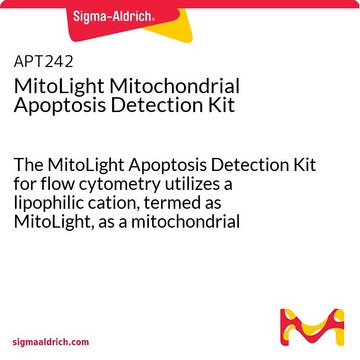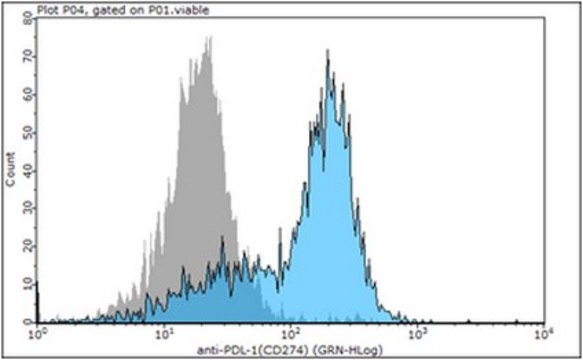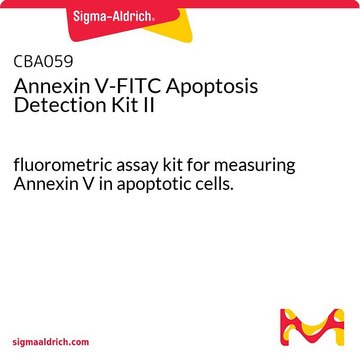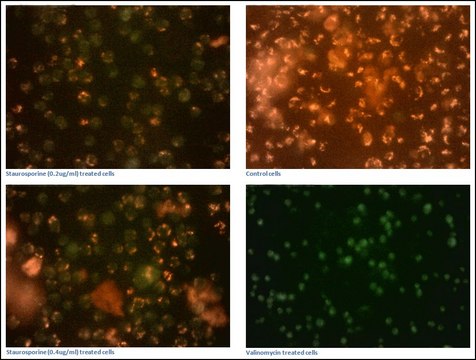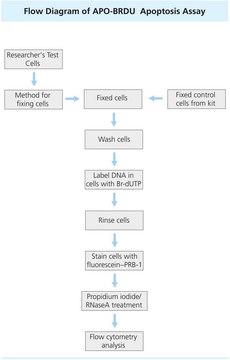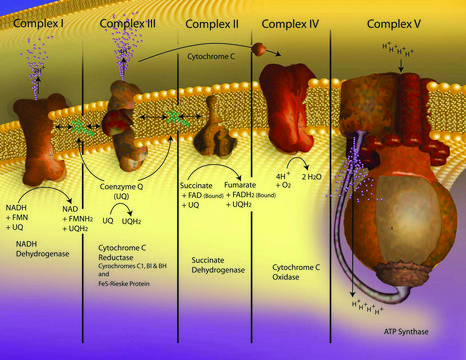APT142
MitoLight Mitochondrial Apoptosis Detection Kit
The MitoLight Apoptosis Detection Kit for flow cytometry utilizes a lipophilic cation, termed as MitoLight, as a mitochondrial activity marker.
Sign Into View Organizational & Contract Pricing
All Photos(2)
About This Item
UNSPSC Code:
12161503
eCl@ss:
32161000
NACRES:
NA.32
Recommended Products
Quality Level
manufacturer/tradename
Chemicon®
MitoLight
technique(s)
flow cytometry: suitable
detection method
fluorometric
shipped in
dry ice
General description
Disruption of the mitochondrial transmembrane potential is one of the earliest intracellular events that occur following induction of apoptosis. The MitoLight Apoptosis Detection Kit utilizes a lipophilic cation, termed as MitoLight, as a mitochondrial activity marker. MitoLight is a mitochondrial dye that stains mitochondria in living cells in a membrane potential-dependent fashion. The monomer is in equilibrium with so-called J-aggregates, which are favored at higher dye concentration or higher mitochondrial membrane potential.
MitoLight partitions differently in healthy cells than in apoptotic cells. Therefore, it has been possible to use a fluorescence ratioing technique to study mitochondrial membrane potentials. In healthy cells, the dye accumulates and aggregates in the mitochondria, giving off a bright red fluorescence (λem = 585-590 nm). In apoptotic cells with altered mitochondrial membrane potential, the dye in its monomeric form stays in the cytoplasm, fluorescing green (λem = 527-530 nm), providing a ready discrimination between apoptotic and nonapoptotic cells. The fluorescence can be observed by fluorescence microscopy using a band-pass filter (detects FITC and rhodamine) or analyzed by flow cytometry using FITC channel for green monomers (Ex/Em = 488/530) and PI channel for red aggregates (Ex/Em = 488/585).
For research use only; Not for use in diagnostic procedures
MitoLight partitions differently in healthy cells than in apoptotic cells. Therefore, it has been possible to use a fluorescence ratioing technique to study mitochondrial membrane potentials. In healthy cells, the dye accumulates and aggregates in the mitochondria, giving off a bright red fluorescence (λem = 585-590 nm). In apoptotic cells with altered mitochondrial membrane potential, the dye in its monomeric form stays in the cytoplasm, fluorescing green (λem = 527-530 nm), providing a ready discrimination between apoptotic and nonapoptotic cells. The fluorescence can be observed by fluorescence microscopy using a band-pass filter (detects FITC and rhodamine) or analyzed by flow cytometry using FITC channel for green monomers (Ex/Em = 488/530) and PI channel for red aggregates (Ex/Em = 488/585).
For research use only; Not for use in diagnostic procedures
Application
Research Category
Apoptosis & Cancer
Apoptosis & Cancer
Components
MitoLight (Part No. 71612): 25 μL in DMSO.
10X Incubation Buffer (Part No. 71614): 20 mL.
10X Incubation Buffer (Part No. 71614): 20 mL.
Storage and Stability
Store kit materials at -20°C up to their expiration date. After thawing, unused kit components can be refrozen. For best results, aliquot the MitoLight reagent into separate vials to avoid repeated freeze/thaw cycles.
PROTECT REAGENTS FROM LIGHT.
PROTECT REAGENTS FROM LIGHT.
Legal Information
CHEMICON is a registered trademark of Merck KGaA, Darmstadt, Germany
Disclaimer
Unless otherwise stated in our catalog or other company documentation accompanying the product(s), our products are intended for research use only and are not to be used for any other purpose, which includes but is not limited to, unauthorized commercial uses, in vitro diagnostic uses, ex vivo or in vivo therapeutic uses or any type of consumption or application to humans or animals.
Storage Class Code
10 - Combustible liquids
Certificates of Analysis (COA)
Search for Certificates of Analysis (COA) by entering the products Lot/Batch Number. Lot and Batch Numbers can be found on a product’s label following the words ‘Lot’ or ‘Batch’.
Already Own This Product?
Find documentation for the products that you have recently purchased in the Document Library.
Yue Tang et al.
Neural regeneration research, 7(14), 1101-1105 (2012-05-15)
In the present study, PC12 cells induced by 6-hydroxydopamine as a model of Parkinson's Disease, were used to investigate the protective effects of bone marrow-derived mesenchymal stem cells bone marrow-derived mesenchymal stem cells against 6-hydroxydopamine-induced neurotoxicity and to verify whether
Kolaviron protects apoptotic cell death in PC12 cells exposed to Atrazine.
Abarikwu SO, Farombi EO, Kashyap MP, Pant AB.
Free Radical Research null
Maria Elisabetta Clementi et al.
International journal of molecular medicine, 43(6), 2523-2531 (2019-04-25)
Docosahexaenoic acid (DHA) is an omega‑3 polyunsaturated fatty acid, derived mainly from fish oil. It is well known that DHA is present in high concentrations in nervous tissue and plays an important role in brain development and neuroprotection. However, the
Mahendra Pratap Kashyap et al.
PloS one, 6(3), e17757-e17757 (2011-03-30)
Monocrotophos (MCP) is a widely used organophosphate (OP) pesticide. We studied apoptotic changes and their correlation with expression of selected cytochrome P450s (CYPs) in PC12 cells exposed to MCP. A significant induction in reactive oxygen species (ROS) and decrease in
Mahendra P Kashyap et al.
Stem cells and development, 22(2), 224-238 (2012-08-18)
Inhibition mechanisms of protein kinase B (Pkb)/Akt and its consequences on related cell signaling were investigated in human umbilical cord blood stem cells (hUCBSCs) exposed to monocrotophos (MCP, an organophosphate pesticide). In silico data reveal that MCP interacts with kinase
Our team of scientists has experience in all areas of research including Life Science, Material Science, Chemical Synthesis, Chromatography, Analytical and many others.
Contact Technical Service